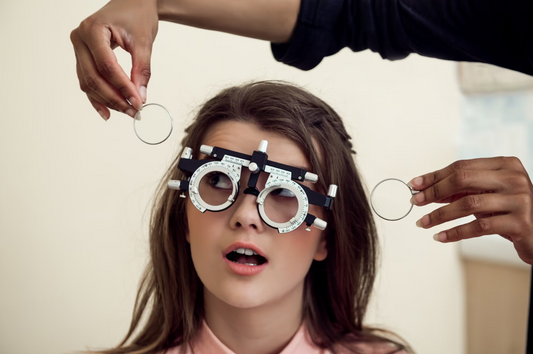When you get an eye exam, your optometrist or ophthalmologist will provide you with a prescription for glasses or contact lenses. This prescription contains various measurements and numbers that describe your eyesight and the lenses you need to correct any vision problems. One of these measurements is SPH, which stands for "sphere" or "spherical."
Understanding Eye Prescriptions
Before we dive into what SPH means for glasses, it's essential to understand how eye prescriptions work. Eye prescriptions contain several measurements and numbers that describe your eyesight and the lenses you need to correct any vision problems. The following are some of the most common measurements found on an eye prescription:
- SPH (sphere)
- CYL (cylinder)
- AXIS
- ADD (addition)
What Does SPH Stand for in Glasses?
SPH stands for "sphere" or "spherical." It is a measurement of the lens power needed to correct nearsightedness or farsightedness. SPH is measured in diopters (D), which is a unit of measurement that describes the refractive power of a lens.
How is SPH Measured?
SPH is measured using a phoropter, which is a specialized instrument used to measure refractive errors. Your optometrist or ophthalmologist will ask you to look through the phoropter and adjust the lenses until you can see the letters on the eye chart clearly. The result of this test is your SPH measurement.
How Does SPH Affect Your Vision?
SPH is a measurement of the lens power needed to correct nearsightedness or farsightedness. If your SPH measurement is positive, it means you are farsighted, and if it's negative, it means you are nearsighted. Your SPH measurement determines the strength of the lenses you need to correct your vision and see clearly.
What Happens if Your SPH is Not Corrected?
If your SPH is not corrected, it can lead to blurry vision, eye strain, headaches, and other vision problems. It's essential to get regular eye exams and update your glasses or contact lenses as needed to ensure your SPH is corrected.
Common SPH Corrections
The following are some common SPH corrections:
- Positive SPH (farsightedness): If you have a positive SPH, you need lenses that are thicker in the middle than at the edges to correct your vision. These lenses are called convex or plus lenses.
- Negative SPH (nearsightedness): If you have a negative SPH, you need lenses that are thicker at the edges than in the middle to correct your vision. These lenses are called concave or minus lenses.
Choosing the Right Lenses for Your SPH
When choosing lenses for your SPH, there are several options to consider, including:
- Single-vision lenses: These lenses correct vision at one distance, either for distance or reading.
- Bifocal or progressive lenses: These lenses correct vision at both distance and near vision.
- High-index lenses: These lenses are thinner and lighter than traditional lenses and are a good option for people with high SPH measurements.
SPH in Contact Lenses
SPH is also a measurement used for contact lenses. Contact lenses come in different SPH measurements, just like glasses. Your optometrist or ophthalmologist will measure your SPH and prescribe the right contact lenses for your vision needs.
SPH in Bifocal and Progressive Lenses
Bifocal and progressive lenses correct both distance and near vision and have two or more SPH measurements. The top part of the lens corrects distance vision, and the bottom part corrects near vision. The SPH measurement for the top part of the lens is for distance vision, and the SPH measurement for the bottom part of the lens is for near vision.
SPH in Refractive Surgery
Refractive surgery, such as LASIK or PRK, can correct SPH by reshaping the cornea. The goal of refractive surgery is to provide a smooth, even surface for light to enter the eye, allowing for clear vision without the need for glasses or contact lenses.
Lifestyle Changes to Improve SPH
There are several lifestyle changes you can make to improve your SPH, including:
- Eating a healthy diet rich in vitamins and minerals
- Getting regular exercise
- Protecting your eyes from the sun
- Practicing good eye hygiene
- getting regular eye exams and updating your glasses or contact lenses as needed
While these lifestyle changes may not directly improve your SPH measurement, they can help maintain good eye health and prevent vision problems from worsening.
Prevention of SPH
While some people may be more prone to developing SPH due to genetics, there are steps you can take to prevent vision problems and maintain good eye health. These include:
- Getting regular eye exams
- Practicing good eye hygiene
- Protecting your eyes from UV rays and blue light
- Eating a healthy diet rich in vitamins and minerals
- Getting regular exercise
Living with SPH
Living with SPH is manageable with the right corrective lenses or refractive surgery. It's essential to get regular eye exams and update your glasses or contact lenses as needed to ensure your SPH is corrected. With proper care and attention, you can maintain good eye health and clear vision.
Conclusion
SPH is an essential measurement in eye prescriptions that describes the lens power needed to correct nearsightedness or farsightedness. It's crucial to get regular eye exams and update your glasses or contact lenses as needed to ensure your SPH is corrected. With the right corrective lenses or refractive surgery, living with SPH is manageable.








